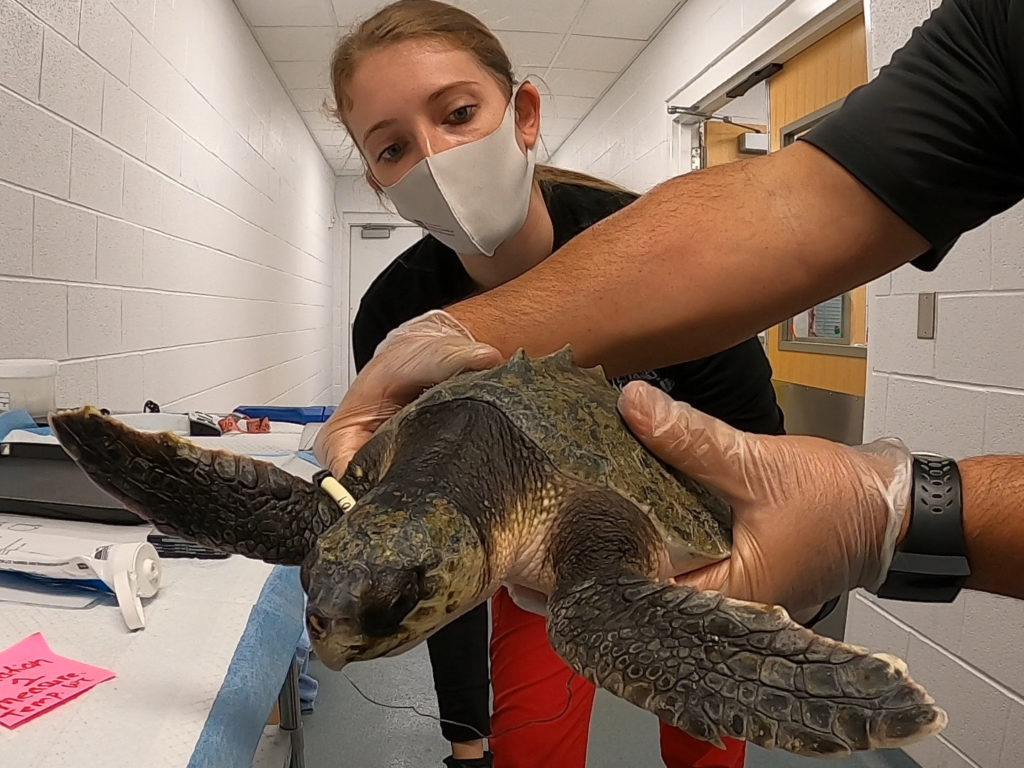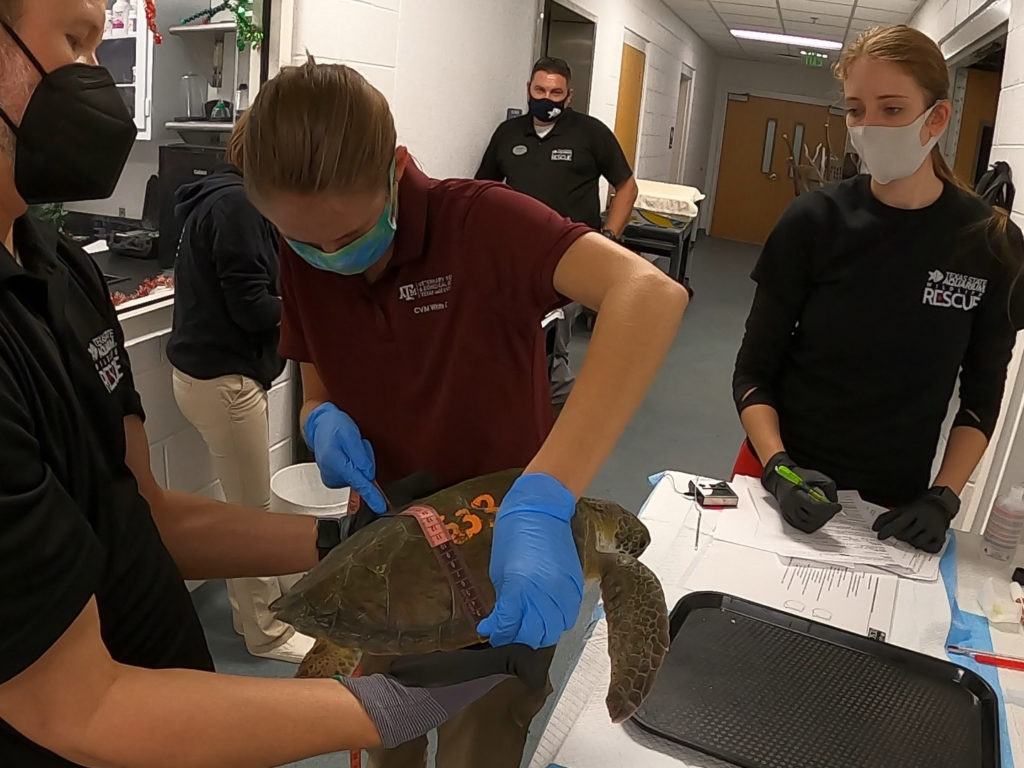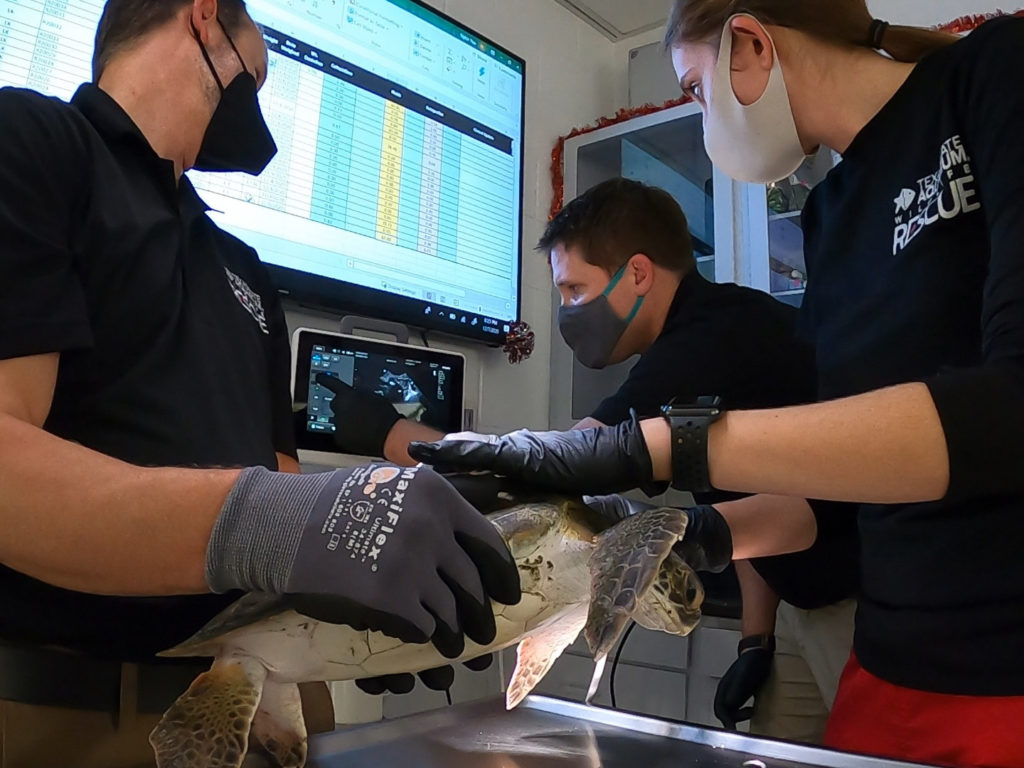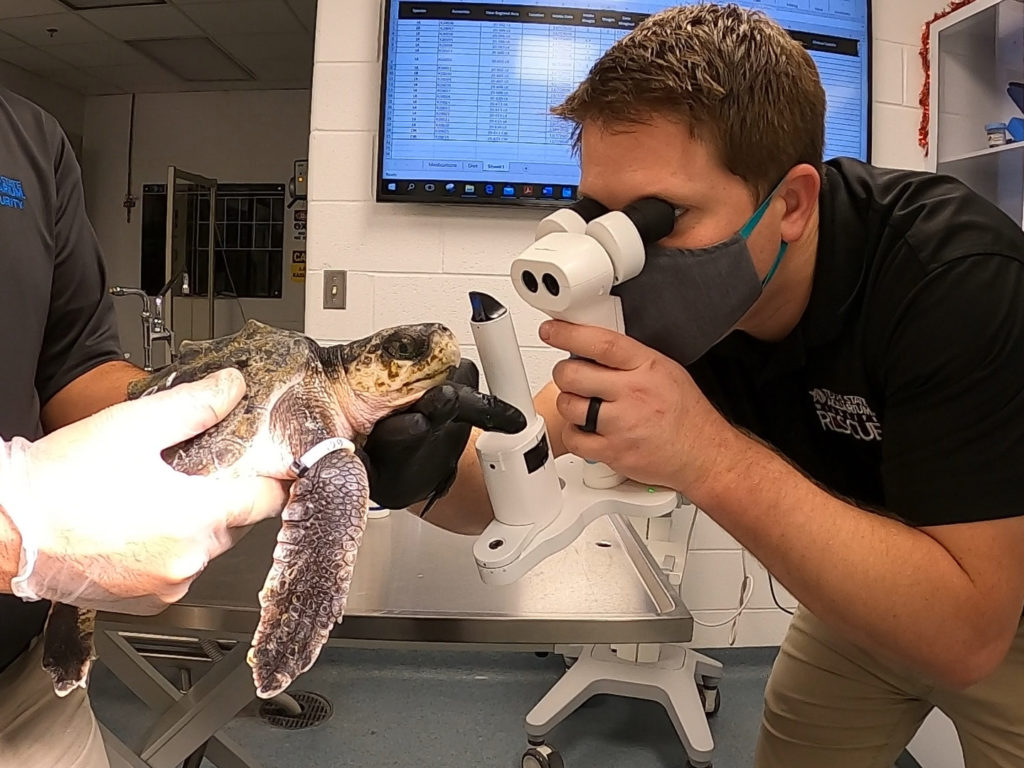Texas A&M Veterinary Students Help Treat Cold-Stunned Sea Turtles
Story by Megan Myers, CVMBS Communications

Two Texas A&M College of Veterinary Medicine & Biomedical Sciences (CVMBS) veterinary students had the rare opportunity to care for endangered sea turtles found on Massachusetts beaches suffering from hypothermia and other complications.
On Dec. 7, more than 120 cold-stunned turtles were found in Cape Cod, Massachusetts. Because there were too many for the local New England Aquarium to treat on its own, the majority of the turtles were flown the same day to accredited facilities under the Association of Zoos and Aquariums for further care and conservation efforts.
Twenty of these turtles were brought to the Texas State Aquarium’s Wildlife Rescue Center in Corpus Christi, where fourth-year veterinary student Melanie Pearson was doing an externship to learn more about aquarium and wildlife medicine. She was joined on that Monday by third-year veterinary student Kaitlyn Upton, who volunteered to help care for the turtles.
The two students worked with the aquarium’s veterinary team, which included Dr. Taylor Yaw ’14 and veterinary technologist Morgan Rosenbaum, a graduate of Texas A&M University–Kingsville’s veterinary technology program.
CVMBS associate professor Dr. J. Jill Heatley also assisted the team by bringing important blood testing and analysis equipment from College Station to collect samples and determine trace element and metal levels in the turtles.

As soon as the turtles arrived, the team sprang into action.
“What was really important to us when they first arrived was getting blood samples from all of them, getting x-rays, doing an ultrasound, and just generally assessing their physical condition,” Pearson said. “We knew that they probably all had pneumonia and were possibly very critically ill, so we really wanted to get a complete picture immediately.
“We also wanted to get them into water as soon as possible because, anatomically, sea turtles are just not designed to be out of water for long periods of time. They can get some bruising on their plastron, or the bottom part of their shell,” she said. “So with all those things in mind, we essentially set up an assembly line.”
As the turtles traveled from one station to the next, they were measured and assigned a number for tracking by Upton, had blood drawn by Yaw, were x-rayed by Rosenbaum, and were given a full physical exam and ultrasound by Yaw and Pearson.
“Obviously, with ultrasound, you can’t see through the shell very well, but if you look through what you would think of as the shoulder pocket or hip pocket, you can see many different things,” Pearson said. “Dr. Yaw supervised closely but let me take the lead on a lot of it. That was probably the most exciting part for me, being able to practice those exam skills.”
Finally, the turtles received fluids to treat their dehydration and medicine to treat the pneumonia and were sent to the Wildlife Rescue Center’s pools to fully recover, a process that could take months or up to a year.

While the Texas State Aquarium regularly treats endangered wildlife, it is not as common of an experience for veterinary students. According to Pearson, being able to directly help endangered animals was an amazing aspect of her externship.
“I’ve worked with wildlife and endangered species before but lately it hasn’t been as much on my mind because I’ve been so focused on getting through veterinary school,” she said. “This whole experience has completely rekindled my passion for it and for my desire to work with wildlife species that have the chance to be released back into the wild after treatment. My goal is to continue to make that a part of my career as I move forward.”
In addition to the joy that comes with helping wildlife, Pearson was excited to work with a team of Aggies and Rosenbaum, a longtime friend.
“This externship is definitely one of my favorites, if not my absolute favorite, in part because of the team,” Pearson said.
“Veterinarians wouldn’t be able to do what they do without veterinary technicians, and Morgan’s living proof of that,” she said. “I learn a lot from her, with all of the knowledge she has about the field since she’s been out in it while I’ve been in school. I also can’t say enough good things about A&M–Kingsville and the education she got there.
“Dr. Yaw is also one of my favorite veterinarians I’ve had the opportunity to work with this year,” Pearson continued. “Every time we do something, he’s quizzing me on everything from anatomy to pharmacology. He’s just an incredible teacher and I feel like I’m learning something new every day.”

Likewise, according to Yaw, training students is a valuable and rewarding aspect of his job at the aquarium.
“Since arriving at the Texas State Aquarium and Wildlife Rescue program, it has been a personal mission to get our veterinary and veterinary technology student programs up and running so that we can actively be a part of training the next generation of aquarium and wildlife medical professionals,” Yaw said. “Getting to work with Aggie students has really come full circle for me here at the aquarium and wildlife rescue. It was only a few years ago that I was sitting in their shoes, as I too traveled to Corpus Christi as a student to learn more about aquatic animal and wildlife medicine.
“The students are always so energetic and excited; for many, it is their first time working with many of the species we provide medical care,” he said. “Melanie and Kaitlyn were a huge help during this cold stun event and their excitement was contagious. We only get to have the students for a short time, but the work we do as a team is so intensive and involved that we really get to know each student on a personal level and consider them a part of our larger aquarium family.”
###
For more information about the Texas A&M College of Veterinary Medicine & Biomedical Sciences, please visit our website at vetmed.tamu.edu or join us on Facebook, Instagram, and Twitter.
Contact Information: Jennifer Gauntt, Director of CVMBS Communications, Texas A&M College of Veterinary Medicine & Biomedical Sciences; jgauntt@cvm.tamu.edu; 979-862-4216


